Tall, vigorous, extremely xeric yarrow. Can spread by seed.
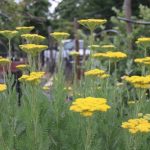
- Fernleaf Yarrow
- 3
- Sun
- 3' x 3'
- Central Asia


Tall, vigorous, extremely xeric yarrow. Can spread by seed.
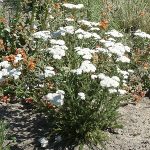
Western White Yarrow is a tough native wildflower with fragrant, lacy foliage and dense umbels of tiny white flowers in summer. Can spread aggressively by seed. Great attractor of beneficial insects. Tolerates variety of soil conditions. Pollinators: Butterflies and native bees. Firewise. More information here.
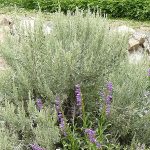
Mountain Big Sage is a more compact, tidy version of the common big sagebrush. Grey-green foliage provides structure in the garden and winter interest.
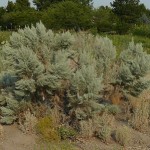
The keystone species in our native landscape. Big sagebrush grows at lower elevations and needs no water once established. It is the principal food and cover for sage grouse. More information here.
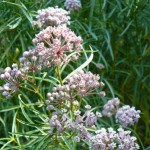
Narrow Leaf Milkweed, native to Southern Idaho, is smaller and more drought-tolerant than the better-known Showy Milkweed. Mauve-pink flowers emerge in mid-summer. With extra water, bloom time is extended. Host plant for Monarch butterflies.
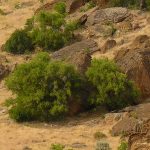
Hackberry is a deciduous native tree, growing on rocky outcroppings on dry slopes in Southern Idaho. Often gnarly, graceful and sculptural in form. Great tree for small areas; berries loved by birds; Native Americans crushed and ate the fruit with parched corn. Firewise.
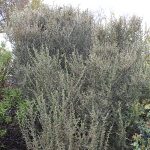
This short, relatively compact shrub is closely related to Curleaf Mountain Mahogany, Fairly slow-growing and evergreen. More information here.
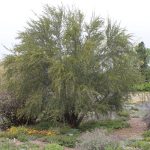
Mountain Mahogany is an attractive evergreen, large shrub to small tree with spreading open crown of thick, twisted branches and furrowed reddish brown bark This beautiful Owyhee County native will tolerate heavy pruning and is browsed into beautiful bonsai-like shapes in the wild. Firewise. More information here.
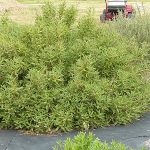
Fernbrush is a multi-stemmed native shrub to small tree with red, shredding bark. Fragrant fern-like foliage and white clusters of rose-like flowers in mid-summer. Adaptable to many soil types and requires little or no additional moisture once established. More information here.
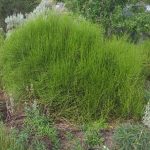
Mormon Tea is an evergreen shrub is native to the high desert of Nevada, Utah and other western states. The bare green stems are marked by the tiny brown ridges which are actually the plant’s leaves. Tolerates clay. Dramatic! Firewise.
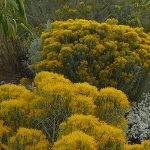
Rubber Rabbitbrush is a tough native shrub covered with brilliant display of golden flowers in fall. Its upright form and graceful silver foliage make it an ideal foundation plant in the xeric garden. Supports butterflies & birds. Needs good drainage. Pollinators: butterflies, small bees. . More info here.
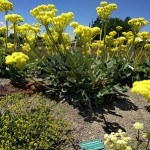
Arrow Leaf Buckwheat has big oval, pointed leaves basal leaves with leafless stems of cream to yellow pom-poms overhead. Thrives in hot, dry and poor soils. Unusually large buckwheat. More information here.
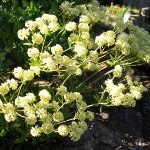
Whorled Buckwheat has leathery leaves which form a basal mat sending up brilliant white, cream color pom-poms in early summer. Likes well-drained soil. Boise foothills native. Pollinators: butterflies, bees.
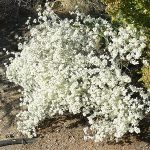
Strict Buckwheat has gorgeous sprays of pinkish-white flowers that glow in the late summer/early autumn garden. Supports native bees and is a late season nectar source for honeybees. Boise foothills native. More information here.
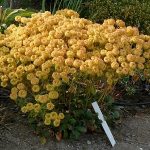
Sulfur Buckwheat is arguably the best all-around landscape plant native to S. Idaho. Bright yellow flower heads rise over a mat of spoon-shaped leaves and mature into a lovely copper color over the summer. The basal leaves turn reddish-green in the fall and are attractive all winter long. Boise foothills native. Pollinators: butterflies, bees. Firewise.
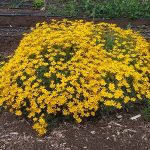
Woolly Sunflower, also called “Oregon Sunshine” (in Oregon!), is one of the real standouts among native Idaho flowering plants. Relatively abundant but usually small in the wild, Woolly Sunflower grows to impressive size in the garden with a bit of extra water. It puts on a beautiful flush of yellow daisies in the late spring; foliage is semi-evergreen and handsome otherwise.

Apache Plume is a sturdy multi-branched Southwest native shrub. Its small white, rose-like flowers emerge over a long blooming season and are a favorite of honey bees and other bees. It is our favorite bee plants! The flowers are followed by charming, fluffy seed heads that give the plant its name. More info here.
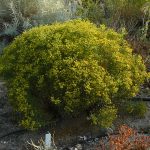
Broom Snakeweed has attractive deep green, finely cut foliage on this tough Owyhee County native. Plants are completely covered with tiny yellow blossoms, mid to late summer and into early fall. Evergreen.

Maximilian’s Sunflower is a vigorous perennial sunflower that comes back from roots every spring and grows to 5 or 6 feet. In late summer a profusion of smallish sunflowers, cover the upright stalks. Excellent fall interest, great along fences. Late season nectar source for bees and butterflies.
Tall spikes of tubular red flowers in summer attract hummingbirds. The basal leaves are long and narrow, but not sharp as in a true Yucca. Needs well-drained soil.
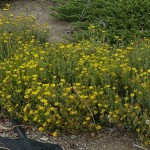
Hairy Goldenaster covers itself completely with small yellow aster-like flowers in early summer. Needs no water once established.
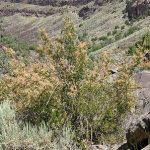
Similar to the more common Ocean Spray, but growing in hotter, drier conditions. It thrives in dry rocky desert valleys and hillsides from Idaho south to Arizona and New Mexico. Foamy waves of white flowers cover this native shrub in summer. Supports native pollinators. Firewise.
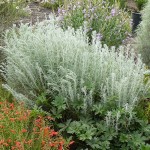
Winterfat is a low-growing, compact xeric shrub. Produces tiny white flowers in summer followed by ornamental woolly white seed heads in fall. Exciting in dried arrangements. Attracts birds & tolerates alkaline soils. An eye-catcher.
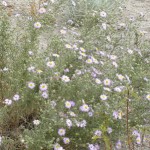
Hoary Aster: The big purple daisies of this fall-blooming biennial light up the Boise foothills in fall. In the garden, the plants will flower vigorously, then self-sow and reappear the following year. Pollinators: bees, butterflies.
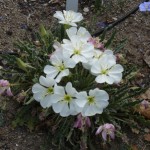
Fragrant Evening Primrose: Silken white blossoms unfurl each evening over shiny deep green mounds of leaves, slipping to a rosy tint with midday heat. The fragrance is sweet and exotic, contrasting sharply with the native surroundings of dry foothills, shrub steppe and pinyon-juniper. Tolerant of poor well-drained soils, and clay. Firewise. More information here.
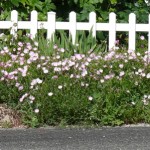
Showy Evening Primrose is a heat-loving beauty, thriving in sunny, dry areas. It can spread rapidly on shallow roots and can overrun smaller, less vigorous plants. Preferring unimproved, well-drained soils, this plant requires little extra water once established. Firewise. More information here.
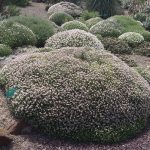
Intricately branched wiry shrublet forming somewhat prickly mound-like cushions. Completely covered with soft pink flowers in late spring.
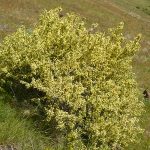
Bitterbrush is a highly branched native shrub often with spectacular yellow spring bloom. Could replace forsythia in native, xeric gardens. Good wildlife habitat. Pollinators: butterflies, bees. Firewise. More info here.
Woods Rose has fragrant, pink rose flowers which profusely bloom. A freely suckering native. Can bloom in full shade as well as full sun.
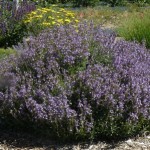
Dwarf Culinary Sage grows into a shrub covered with a dense mound of edible leaves. Covered with showy lavender-blue flowers in early summer, it becomes a magnet for honeybees. Unlike ordinary culinary sage, this dwarf form is completely evergreen, creating a beautiful gray-green mound in the winter garden. Tolerates clay and shade. Firewise.
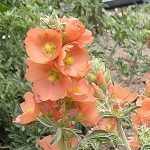
This low-growing Globemallow travels by root and colonizes very dry areas with poor soil. Tolerates clay. Flower color can vary from orange to red. More information here.
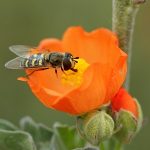
Gooseberry Globemallow’s red-orange flowers bloom in spring & summer. Attracts all kinds of native pollinators.
Munro’s globemallow has dark maroon stems with dark-green, cut, lobed leaves and many heads of clear orange flowers.
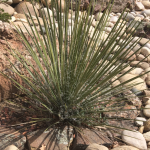
This handsome yucca has narrow, evergreen, spiky leaves and sends up a tall stalk of fragrant white flowers in late summer. Likes full sun and well-drained, sandy loam. Firewise and evergreen. More information here.
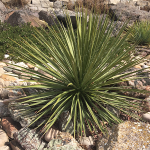
Clumps of thin, stiff, leathery white-margined leaves eventually produce flower stalks with creamy white bells. Evergreen. Firewise.